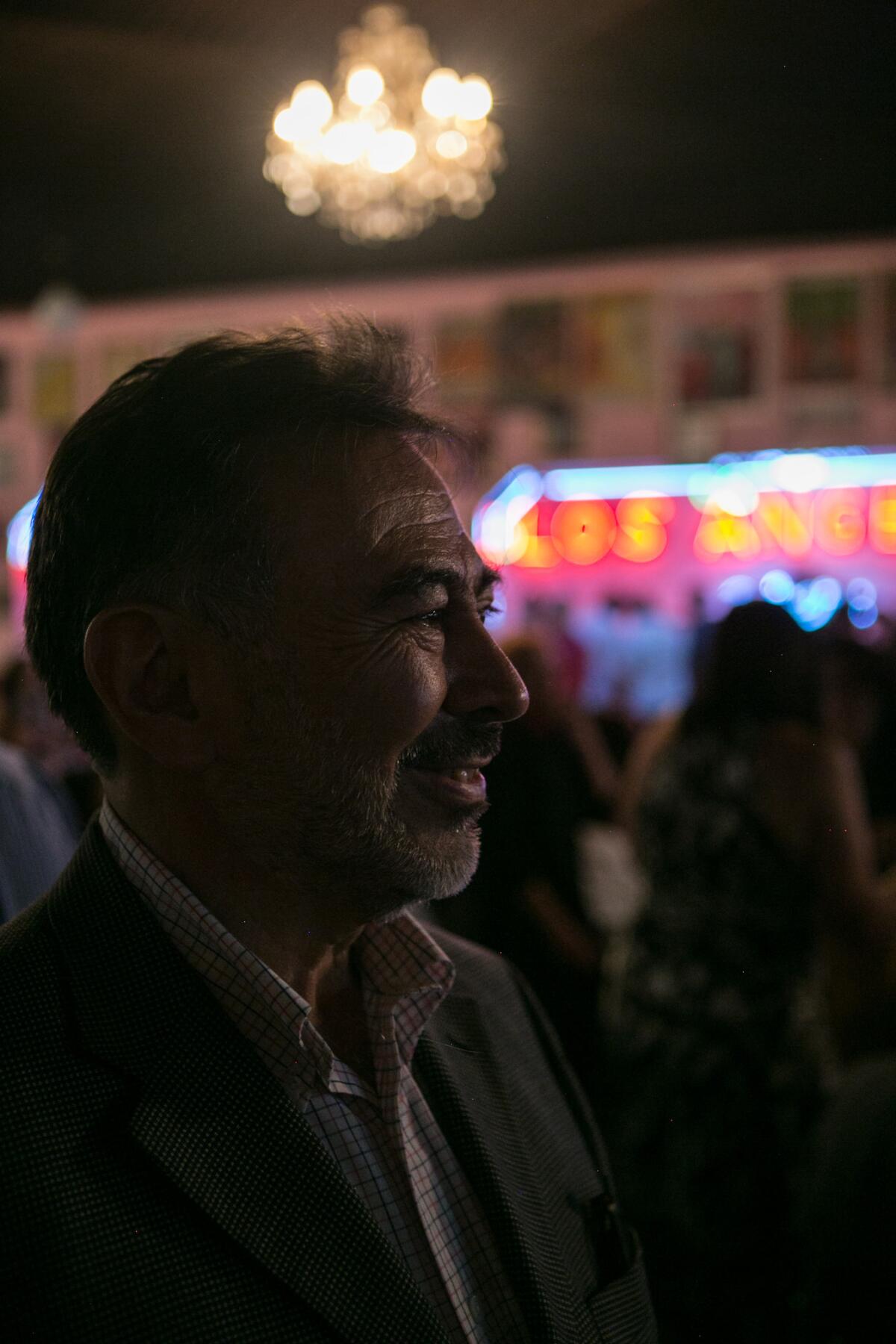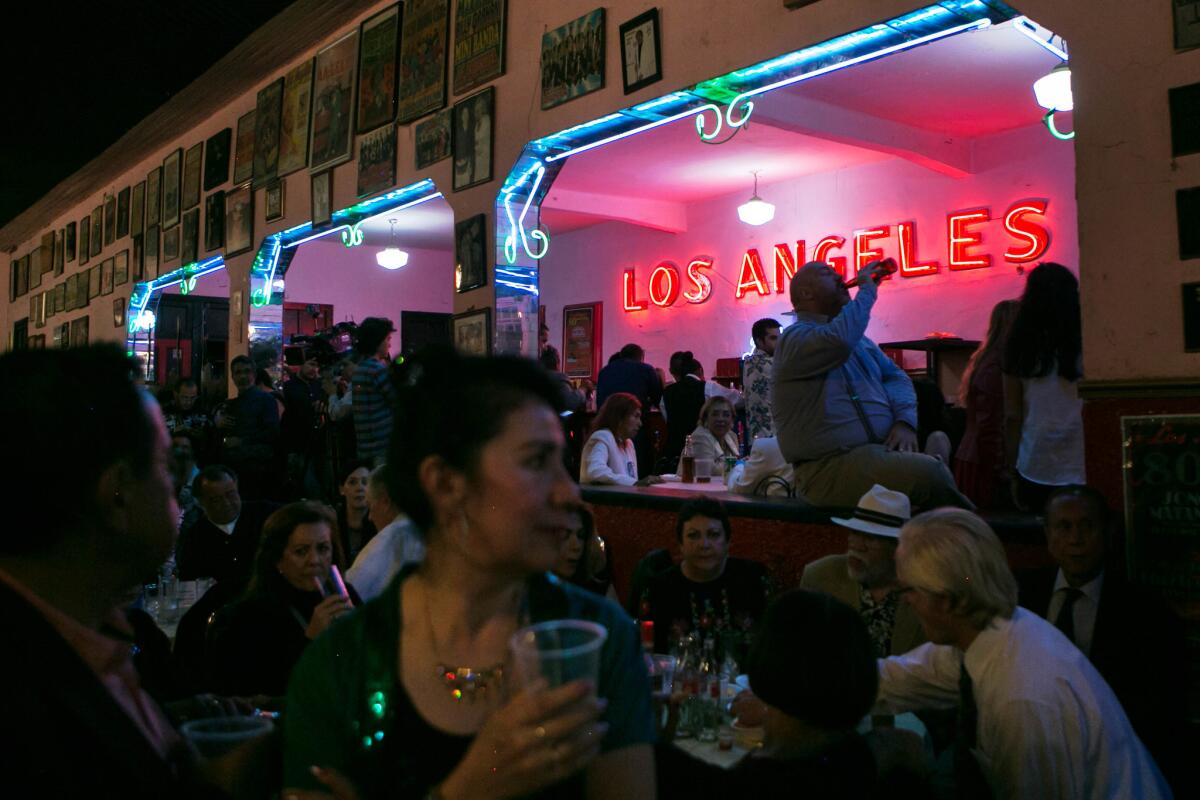Fidel Castro and Frida Kahlo came here. Why the oldest dance hall in Mexico City isn’t quitting yet
- Share via
The old dance hall doesn’t turn as much of a profit as it used to. Young people these days would rather play video games than cha-cha or do the twist.
But Miguel Nieto, whose grandfather opened Salon Los Angeles 80 years ago this week, refuses to quit, even as his gray-haired regulars dwindle, even as developers dream about turning the nightclub into condominiums like the concrete apartment tower going up across the street.
“I’m stubborn,” said Nieto, who twice a week brings live orchestras into his Mexico City nightclub to play salsa, mambo and other kinds of dance music that once reigned supreme in Latin America before rock and reggaeton muscled in. In an era of iPhones, Xbox and Netflix, Nieto likes that Salon Los Angeles is a place where people talk face-to-face and dance cheek-to-cheek.
“I think a business that promotes real human encounters is important,” Nieto said. “This is real life.”
Salon Los Angeles is the country’s oldest dance hall and its best known, in part, because of all the important figures who at one time or another swirled across the sprawling wooden floor.
Muralist Diego Rivera danced here in the 1930s, back when the city was teeming with leftist artists and literati. His painter wife, Frida Kahlo, once famously stopped by the salon with Leon Trotsky, the exiled Soviet revolutionary with whom she had a brief affair.
Che Guevara and Fidel Castro both came here, and writers Gabriel Garcia Marquez and Carlos Fuentes drank at the salon bar. Mexican comedic actor Cantinflas, who grew up a few blocks away, was famous for his dance moves at the salon long before he became a star.
Latin music legends Celia Cruz, Ruben Blades and Tito Puente all played here, as the big band music that was popular when the hall opened gave way to tropical rhythms such as salsa and its slowed-down Cuban cousin, danzon.
Strange stuff transpired too, like the time in 1997 when a sect of the Zapatistas, the leftist militant group engaged in a long standoff with the federal government, chose the salon as the place for a major meeting.
“The weirdest things have happened here,” Nieto said.
Nieto was an actuary at Procter & Gamble when his grandfather died and he inherited the business in 1972. He said most of the other members of his family do much more practical work. “They’re not into an 80-year-old dance hall,” he said. “They are not interested in dance or salsa as a way of making a living.”
His grandfather, who worked in the lumber industry, opened the hall in 1937 because he liked music and had plenty of wood to build a dance floor. He named the salon after the neighborhood where it was built — a working-class barrio known as Los Angeles that back then was on the outskirts of Mexico City.
As more Mexicans left to work in the U.S. in the 1960s and ’70s, the salon adopted a slogan that cheekily referenced the large number of Mexicans who had moved to California. “If you don’t know Los Angeles,” the now-famous slogan goes, “you don’t know Mexico.”
That phrase is emblazoned in red neon letters on the outside of the salon’s stuccoed facade. Inside, there’s lots more neon, and the walls are plastered with hundreds of concert posters and photos of the good old days.
On most days, the club is pretty empty, with a small core of regulars showing up Sunday and Tuesday afternoons to step to salsa or danzon. But on a recent Saturday, a line formed down the block hours before the doors opened for a blowout party celebrating the dance hall’s big anniversary. Women in form-fitting dresses and sequins posed for photos with men in bright suits.
“There is so much history here,” said Jose de Jesus Gonzalez de la Rosa, an attorney who wore a baggy zoot suit the color of a carrot. A silver watch chain draped from his pocket, and he had trimmed his mustache in a thin line above his lip. “We are fighting so we don’t lose this beautiful tradition,” he said.
------------
FOR THE RECORD
2:25 p.m. Aug. 4: An earlier version of this article spelled Jose de Jesus Gonzalez de la Rosa’s surname as Gonzales.
------------

Inside, Gloria Serrano Gonzales was among the first to hit the floor. Local journalists there to document the club’s anniversary surrounded Serrano with their cameras, drawn to her toothy smile, curly white afro and dance moves so agile a stranger might question whether she really is 76 years old.
Serrano first visited in 1966. “I’ve found my place,” she said she remembers thinking that first night, impressed not only with the music but also the freedom with which women moved on the floor.
A former nurse who lives an hour and a half away, Serrano has returned weekly since, sometimes toting her kids, her love for Salon Los Angeles outlasting three marriages.
Her fourth and current marriage, to Jose Carmen Castaneda, 70, got its start here when he asked her to dance 20 years ago.
“I knew he was special because it just didn’t feel the same as dancing with others,” she said.
On Saturday, Serrano was joined by her husband and her daughter, Rebeca Arroyo, 38, who first came to the club at age 12 and later went on to study jazz and ballet. Just an hour into the party, they already were sweaty after shimmying to several speedy mambos.
The dance floor was packed. The party had drawn several well-known Mexican actors and politicians, as well as the American ambassador to Mexico, Roberta Jacobson, who had come to celebrate her husband’s birthday.

Serrano and her daughter retreated to their table to cool down, each expertly unfolding paper fans. Serrano’s husband poured her a drink of pineapple juice, and Arroyo mixed a drink with vodka as they took in the crowded scene, which included old-timers as well as a surprising number of young people. Many were documenting the night with their smartphones, but they were dancing too. Nieto walked by, trailed by cameras and beaming.
The musicians, who wore matching outfits with big, ruffled sleeves, launched into another tune, a hopping big-band hit.
Serrano was still breathing heavily, but her husband leaned toward her and gestured to the floor.
“Come on,” he said. “Let’s dance.”
Twitter: @katelinthicum
Sign up for Essential California
The most important California stories and recommendations in your inbox every morning.
You may occasionally receive promotional content from the Los Angeles Times.








